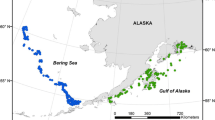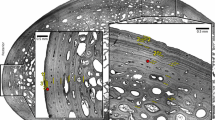Abstract
This study provides the first published age estimates for the roughtail skate, Bathyraja trachura. Age and growth characteristics of B. trachura, a poorly-known deepwater species, were determined from samples collected along the continental slope of the contiguous western United States. A new maximum size was established at 91.0 cm TL. Age was determined using a traditional structure (vertebral thin sections) with widespread application on multiple skate species and a non-lethal structure (caudal thorns) recently used for age analysis on skate species. Caudal thorns were determined not to be a useful ageing structure for this species based on poor precision and significantly lower age estimates when compared to age estimates from vertebral thin sections. The best model for describing growth of B. trachura was the two parameter VBGF, assuming annual vertebral band deposition and using length-at-age data. Although females grew slower and reached a larger maximum size than males, their growth was not statistically different (ARSS; P = 0.90); therefore, data were pooled (L∞ = 99.38, k = 0.09). Annual band deposition was found to be a reasonable assumption for this species, but has yet to be validated. The maximum age estimated for B. trachura was 20 years for males and 17 years for females using vertebral thin sections.









Similar content being viewed by others
References
Beamish RJ, Fournier DA (1981) A method for comparing the precision of a set of age determinations. CA J Fish Soc 112(6):735–743
Beverton RJH, Holt SJ (1957) On the Dynamics of exploited fish populations. Chapman and Hall, New York
Brander K (1981) Disappearance of common skate Raja batis from Irish Sea. Nature (5801) 290:48–49
Brander K, Palmer D (1985) Growth rate of Raia clavata in the northeast Irish Sea. J Cons Int Explor Mer 42:125–128
Cailliet GM, Tanaka S (1990) Recommendations for research needed to better understand the age and growth of elasmobranchs. In: HL Pratt, SH Gruber, T Taniuchi (eds) Elasmobranchs as living resources: advances in the biology, ecology, systematics, and the status of fisheries, vol 90. NOAA Tech. Rep., pp 505–507
Cailliet GM, Goldman KJ (2004) Age determination and validation in chondrichthyan fishes. In: JC Carrier, JA Musick, MR Heithaus (eds) Biology of sharks and their relatives, Chap. 14. CRC Press LLC, Boca Raton, Florida, pp 399–447
Cailliet GM, Smith WD, Mollet HF, Goldman KJ (2006) Age and growth studies of chondrichthyan fishes: the need for consistency in terminology, verification, validation, and growth function fitting. Enviro Bio Fish 77:211–228
Cailliet GM, Martin LK, Kusher D, Wolf P, Welden BA (1983) Techniques for enhancing vertebral bands in age estimation of California elasmobranchs. In: Prince E Pulos L (eds) Proc. Int. Tunas, Billfishes, Sharks. Spec. Sci. Rep./Fish. NMFS 8:179–188, pp 157–165,
Cailliet GM, Mollet HF, Pittenger GG, Bedford D, Natanson LJ (1992) Growth and demography of the Pacific angel shark (Squatina californica), based upon tag returns off California. Aust J Mar Freshwater Res 43:1313–1330
Campana SE (2001) Accuracy, precision and quality control in age determination, including a review of the use and abuse of age validation methods. J Fish Biol 59:197–242
Campana SE, Annand MC, McMillan JI (1995) Graphical and statistical methods for determining the consistency of age determinations. Trans Amer Fish Soc 124:131–138
Casey JM, Myers RA (1998) Near extinction of a large, widely distributed fish. Science 281:690–691
Chang WYB (1982) A statistical method for evaluating the reproducibility of age determination. Can J Fish Aquat Sci 39:1208–1210
Conrath CL, Gelsleichter J, Musick JA (2002) Age and growth of the smooth dogfish (Mustelus canis) in the northwest Atlantic Ocean. Fish Bull 100:674–682
Cox KW (1963) Egg-cases of some elasmobranchs and a cyclostome from Californian waters. Calif Fish and Game 64:271–289
Craig JC (1993) The systematics of the Bathyraja and Rhinoraja (Rajidae) species of the Bering Sea and adjacent areas in the North Pacific ocean. Masters Thesis, Texas A and M University, Texas, p 180
Dulvy NK, Reynolds JD (2002) Predicting extinction vulnerability in skates. Cons Bio 16(2):440–450
Ebert DA (2003) Sharks, rays, and chimaeras of California. University of California Press. Bentley, California, p 284
Fabens AJ (1965) Properties and fitting of the von Bertalanffy growth curve. Growth 29:265–289
Francis MP, Maolagáin CÓ (2005) Age and growth of the Antarctic skate, Amblyraja georgiana, in the Ross Sea. CCAMLR Science 12:183–194
Gallagher M, Nolan CP (1999) A novel method for the estimation of age and growth in rajids using caudal thorns. Can J Fish Aquat Sci 56:1590–1599
Gallagher M, Nolan CP, Jeal F (2005) The structure and growth processes of caudal thorns. J Northwest Atlantic Fish Sci 35(31):125–129
Goldman KG (2004) Age and growth of elasmobranch fishes In: Musick JA, Bonfil R (eds) Elasmobranch fisheries management techniques. APEC Fisheries Working Group, Singapore, pp 97–132
Gruber SH, Stout RG (1983) Biological materials for the study of age and growth in a tropical marine elasmobranch, the lemon shark, Negaprion brevirostris (Poey). US Dep Commer, NOAA Tech Rep NMFS 8:193–205
Haddon M (2001) Modeling and quantitative methods in fisheries. CRC Press LLC, Boca Raton, Florida, p 404
Holden MJ (1972) The growth of Raja brachyura, R. clavata, and R montagui as determined from tagging data. J Cons Int Explor Mar 34(2):161–168
Holden MJ, Meadows PS (1962) The structure of the spine of the spur dogfish (Squalus acanthias) and its use for age determination. J Mar Biol Ass UK 42:179–197
Hyndes GA, Loneragan NR, Potter IC (1992) Influence of sectioning otoliths on marginal increment trends and age and growth estimates for the flathead Platycephalus speculator. Fish Bull 90:276–284
Hubs CL, Ishiyama R (1968) Methods for the taxonomic study and description of skates (Rajidae). Copeia 3:48–3491
Ishihara H, Ishiyama R (1985) Two new North Pacific skates (Rajidae) and a revised key to Bathyraja in the area. Jpn J Ichthyol 32(2):143–179
Ishiyama R (1951) Age determination of Raja hollandi Jordan & Richardson inhabiting the waters of the East China Sea. Bull Jap Soc Sci Fish 16(12):119–124
Johnson AG (1979) A simple method for staining the centra of teleost vertebrae. Northeast Gulf Sci 3:113–115
Licandeo RR, Lamilla JG, Rubilar PG, Vega RM (2006) Age, growth, and sexual maturity of the yellownose skate Dipturus chilensis in the south-eastern Pacific. J Fish Biol 68:488–506
Love MS, Mecklenburg CW, Mecklenburg TA, Thorstein LK (2005) Resource inventory of marine and estuarine fishes of the West coast and Alaska: a checklist of North Pacific and Arctic ocean species from Baja California to the Alaska-Yukon border. U.S Department of the Interior, U.S. Geological survey Biological Resources Division, Seattle, Washington, p 276
Martin L, Zorzi GD (1993) Status and review of the California skate fishery. In: Branstetter S (ed) Conservation Biology of Elasmobranchs. NOAA Tech Rep NMFS 115:39–52
McFarlane GA, King JR (2006) Age and growth of big skate (Raja binoculata) and longnose skate (Raja Rhina) in British Columbia waters. Fish Res 78:169–178
Officer RA, Gason AS, Walker TI, Clement JG (1996) Sources of variation in counts of growth increments in vertebrae from gummy, Mustelus antarcticus, and school shark, Galeorhinus galeus, implications for age determination. Can J Fish Aquat Sci 53:1765–1777
Perez CR (2005) Age, growth, and reproduction of the sandpaper skate, Bathyraja kincaidii (Garman, 1908) in the eastern North Pacific. Masters Thesis, California State University and Moss Landing Marine Laboratory, California, p 100
Ricker WE (1979) Growth rates and models. In: Fish Physiology vol. 3. Academic Press Inc., New York, pp 677–742
Stevens JD, Bonfil R, Dulvy NK, Walker PA (2000) The effects of fishing on sharks, rays, and chimaeras (chondrichthyans), and the implications for marine ecosystems. ICES J Mar Sci 57:476–494
Sulikowski JA, Jurek J, Danley PD, Howell WH, Tsang PCW (2005) Age and Growth estimates of the thorny skate (Amblyraja radiata) in the western Gulf of Maine. Fish Bull 103:161–168
Walker PA, Hislop JRG (1998) Sensitive skates or resilient rays? Spatial and temporal shifts in ray species composition in the central and north-western North Sea between and the present day. ICES J Mar Sci 55:392–402
Waring GT (1984) Age, growth and mortality of the little skate off the northeast coast of the United States. Trans Amer Fish Soc 113:314–321
Zar JH (1999) Biostatistical analysis, 4th edn. Prentice Hall, New Jersey, p 663
Zorzi GD, Martin LK, Ugoretz J (2001) Skates and Rays. In: Leet WS, Dewees CM, Klingbeil R, Larson EJ (eds) California’s living marine resources: a status report. California Department of Fish and Game, California, pp 257–261
Acknowledgements
We thank Guy Fleisher, Keith Bosley, Erica Fruh, Aimee Keller, Victor Simon, and Dan Kamikawa NMFS/Northwest Fisheries Science Center for collecting samples during their yearly groundfish cruises in the eastern North Pacific. We also thank John Cusick and observers at the West coast Groundfish Observer Program for collecting samples throughout the year. We are grateful for the students and staff at Pacific Shark Research Center (PSRC) at Moss Landing Marine Laboratories who helped process and prepare samples for analysis, especially Joe Bizzarro, Colleena Perez, and Wade Smith. Funding for this research was provided by NOAA/NMFS to the National Shark Research Consortium and Pacific Shark Research Center, the National Sea Grant College Program of the U.S. Department of Commerce’s National Oceanic and Atmospheric Administration under NOAA Grant no. NA04OAR4170038, project number R/F−199, through the California Sea Grant College Program and in part by the California State Resources Agency. Samples were collected under IAUCUC protocol #801.
Author information
Authors and Affiliations
Corresponding author
Rights and permissions
About this article
Cite this article
Davis, C.D., Cailliet, G.M. & Ebert, D.A. Age and growth of the roughtail skate Bathyraja trachura (Gilbert 1892) from the eastern North Pacific. Environ Biol Fish 80, 325–336 (2007). https://doi.org/10.1007/s10641-007-9224-7
Received:
Accepted:
Published:
Issue Date:
DOI: https://doi.org/10.1007/s10641-007-9224-7




